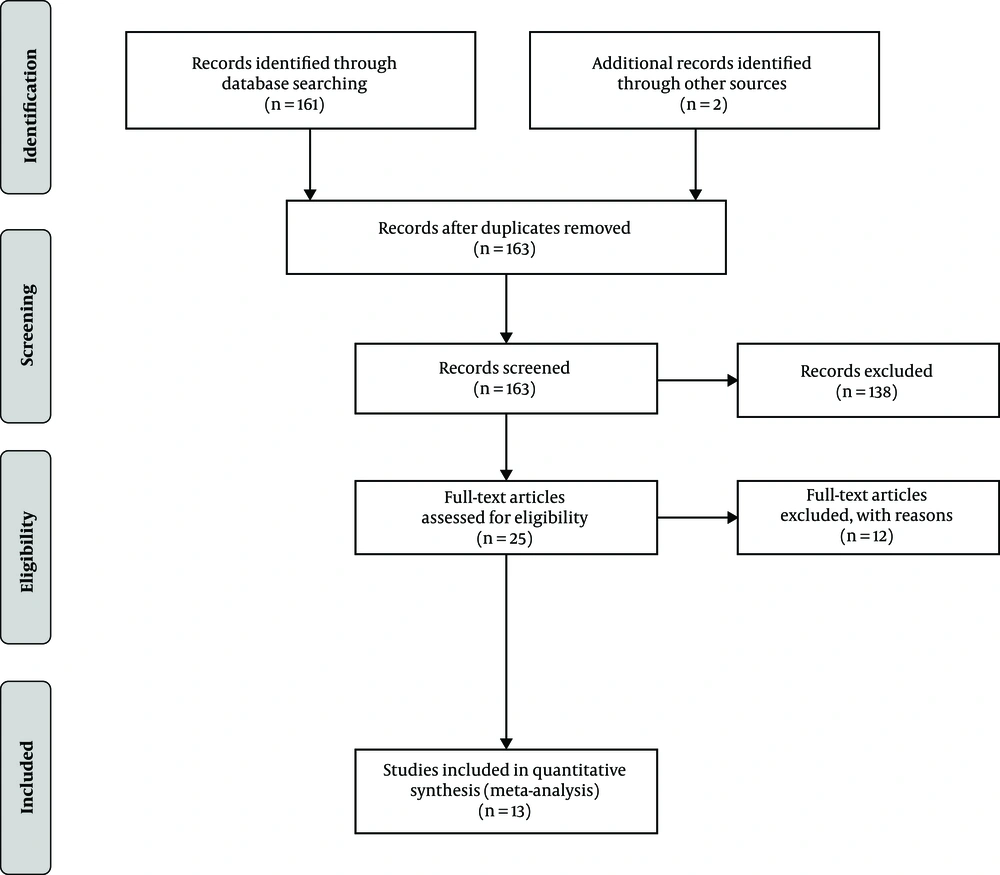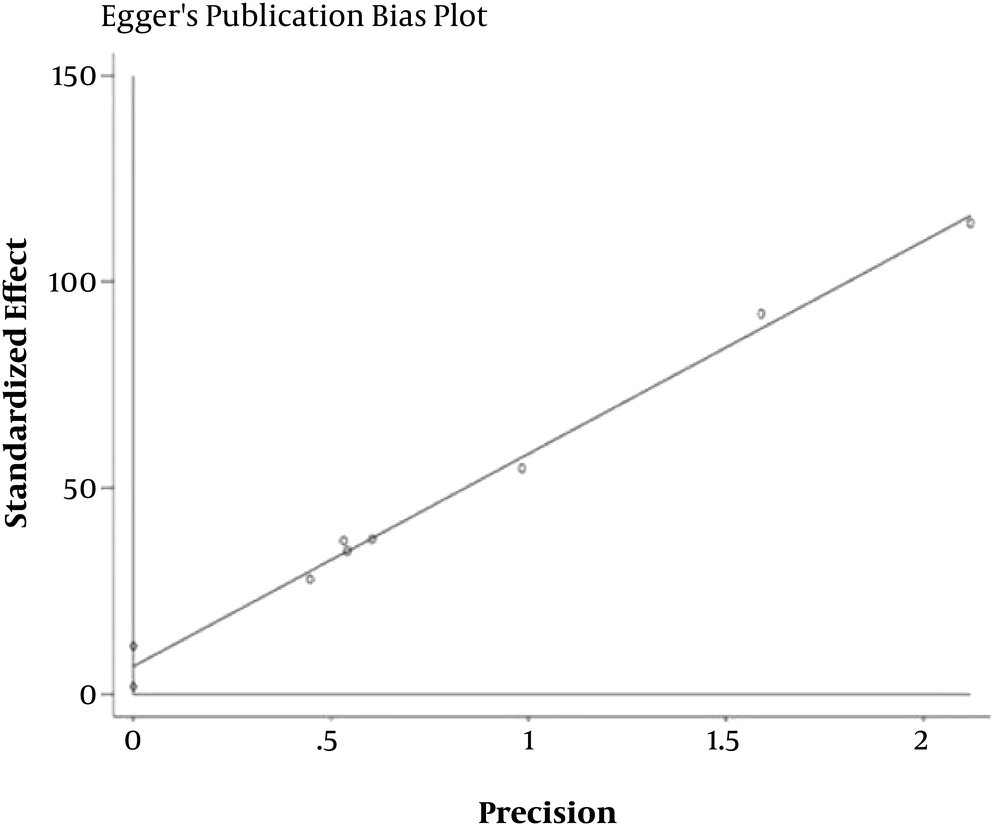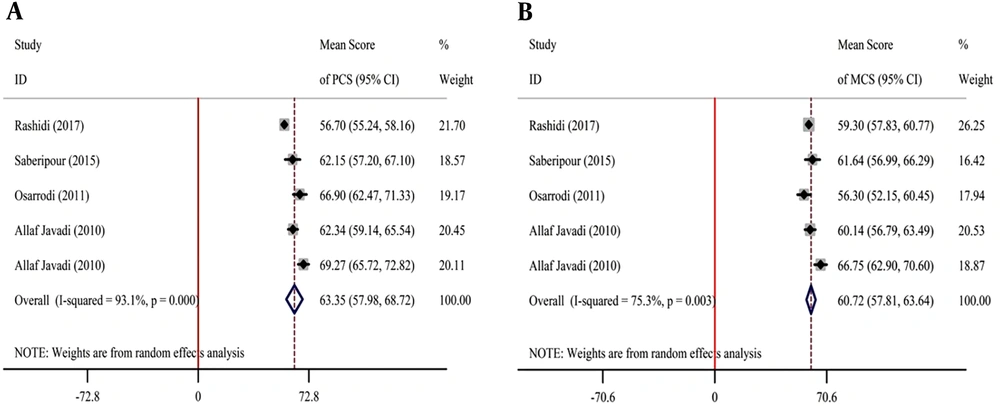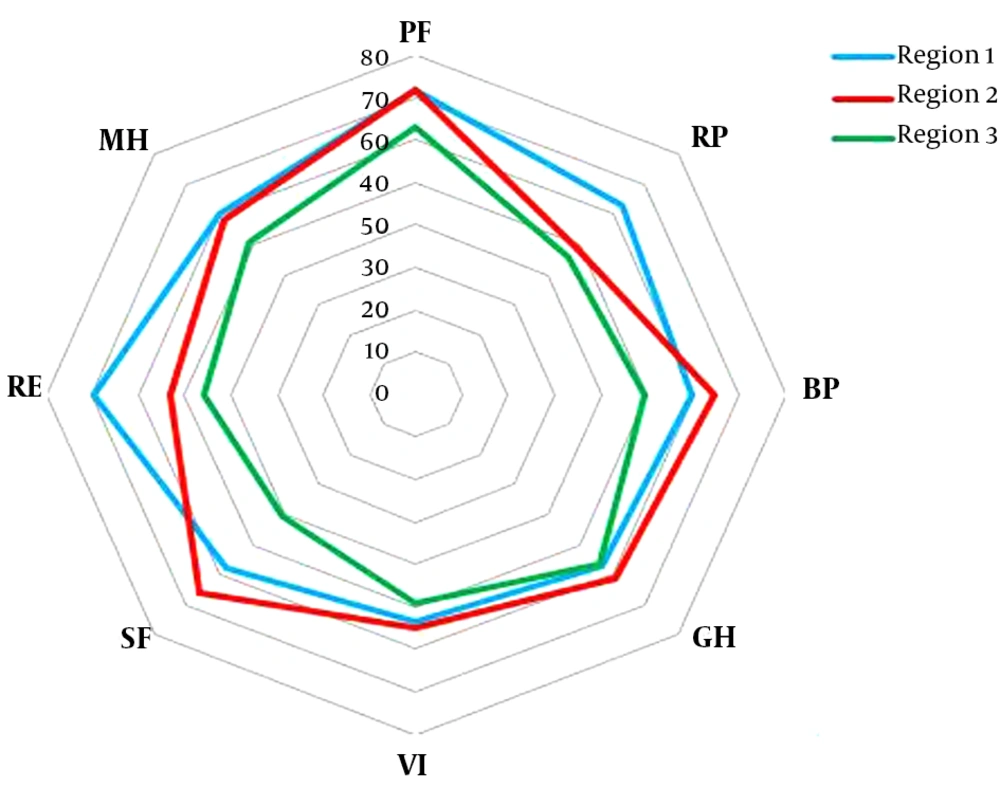1. Background
Nurses include the largest healthcare workforce who provide healthcare for patients with various needs, using their knowledge, skills, and experiences (1). Given the nature of the nursing profession, nurses are always faced with different stressors, including death, illness, and working under high pressure. These stressors can gradually reduce their health-related quality of life (HRQoL) by decreasing their physical and mental strength and impairing their daily functioning (2, 3). On the other hand, occupational hazards always threaten nurses more than other members of the treatment team; for instance, they are encountered with needlestick injuries averagely four times a year, which can lead to the transmission of infectious diseases such as hepatitis B and C, AIDS, syphilis, and brucellosis (4). Job stress is also an unavoidable part of the nursing profession and nurses are faced with high levels of job stress due to such factors as high workload, role conflict, anxiety, inadequate equipment, dealing with patients in bad health conditions, lack of job promotion, inappropriate relationships, and irregular work schedule and work shifts (5-7). Because of close contact with patients and their companions, nurses are also faced with workplace violence more than the other healthcare providers are.
A previous study showed that nurses who considered their health as bad had a lower HRQoL (8). The quality of life is a broader concept than health and encompasses different physical, psychological, cultural, and social aspects of health and HRQoL improvement is one of the most important goals of healthcare systems (9, 10). HRQoL is a subjective concept that refers to the one’s understanding of his position in life in terms of cultural aspects, value system, goals, expectations, standards, and priorities (11). Nurses’ HRQoL is heavily related to the healthcare system’s effectiveness, quality of healthcare service, and patients’ health (12, 13). In developing countries compared to developed ones, nurses have fewer rights and benefits, and less attention is paid to their physical and psychological health. This can have negative effects on their health, reduce the quality of care they provide, and lead to their lower performance, occupational burnout, early retirement, and immigration (9, 14).
Improving nurses’ HRQoL can improve the quality of care provided for the patients (14). Different instruments have been designed to assess HRQoL. The short-form 36 health survey (SF-36) is one of the most popular instruments for assessing the HRQoL that, as a standard instrument, assesses the health outcomes. Moreover, its localized versions have been translated into many languages according to cultural differences (15). The SF-36 is a general questionnaire not limited to a certain group of patients, assessing all the important aspects of health in patients (16). This questionnaire assesses two distinct dimensions of health, physical and psychological, and each dimension is composed of four domains. The physical dimension of HRQoL assesses the domains of physical functioning (PF), role limitation-physical (PR), bodily pain (BP), and general health (GH) while the psychological dimension assesses the domains of vitality (V), social functioning (SF), role limitation-emotional (RE), and mental health (MH) (17).
2. Objectives
Therefore, the present study aimed at (1) the examination of the physical and psychological dimensions of HRQoL in Iranian patients and (2) the joint estimation of the eight HRQoL subscales using the SF-36. The findings could increase the healthcare policymakers’ awareness of the HRQoL of nurses and encourage evidence-based decision-making.
3. Methods
3.1. Search Strategy
This is a systematic review and meta-analysis according to the PRISMA statement (18) aimed at examining the HRQoL of Iranian nurses and its different aspects based on studies published in the Iranian and international journals. Two researchers independently searched the national and international databases, including Scientific Information Database (SID), MagIran, Google Scholar, ISI/Web of Science, PubMed, and Scopus, without time limitation. The reference lists were also reviewed to find other related articles. The searches were conducted using the following keywords: (“quality of life” OR “health-related quality of life” OR “life style” OR “QOL” OR “HRQoL”) AND (“short form questionnaire 36” OR “SF-36”) AND (“nurse” OR “nurses”) AND “Iran”.
3.2. Study Selection and Data Extraction
First, all the articles reporting the HRQoL of nurses were collected. The inclusion criteria included having an observational design and using the SF-36 to assess the HRQoL. The exclusion criteria were duplicated studies, lack of necessary information, and lack of access to full texts. For the extraction of necessary information from the finally selected articles, a checklist was used to assess the following aspects of each article: the name of the first author, the place of publication, the year of publication, the sample size, and the participants’ scores on the eight subscales of HRQoL and on the physical and psychological dimensions of the HRQoL. In order to reduce the bias, each article was reviewed independently by two researchers and if there was any disagreement, the article was reviewed by another author experienced in meta-analysis. In total, 163 articles were found in the initial search, among which 150 articles were excluded due to not being related to the topic. Finally, a total of 13 Persian and English articles were reviewed.
3.3. Quality Assessment
The methodological quality of the studies was assessed using an instrument widely used in Iranian and non-Iranian studies. This instrument assessed the five aspects of the studies, including study design, participants’ demographic data, comparison group, sample size, and instruments used to gather data. A score from 0 to 3 was assigned to each aspect, and higher scores indicated a better methodological quality (4, 19, 20). Based on the score, the articles were divided into three groups: weak (0 to 5), moderate (6 to 10), and strong (above 10). Some studies did not report the mean HRQoL scores on the physical and psychological dimensions, and some did not report the mean scores on the eight HRQoL subscales; therefore, only articles with complete data were included in the analysis.
3.4. Statistical Analysis
As the HRQoL and its dimensions generate quantitative scores, the means and standard deviations of the indices in each study were extracted, and the variance of the means was calculated based on normal distribution using the following formula:
The mean scores of HRQoL and its dimensions were estimated with 95% confidence interval. The I2 statistic and the Cochran’s Q test were used to examine the heterogeneity of the data. When the I2 statistics of above 50% were obtained or P values for the Cochran’s Q test were less than 0.05 (P < 0.05), a random-effects model and otherwise a fixed-effects model was employed for the joint estimation of HRQoL scores. The sensitivity analysis was employed to examine the impact of each study on the overall result. The meta-regression analysis was used to explore the association of physical and psychological dimensions of HRQoL with age and articles’ year of publication, and a subgroup analysis was employed to examine HRQoL based on the five regions of Iran. Publication bias was examined using the Begg’s funnel plot. The data were analyzed using the stata software, version 14. The significance level was set at P < 0.05.
4. Results
In the present study, all papers published in Persian and English focusing on the nurses’ HRQoL were analyzed. In the initial search, articles published in the Iranian and international databases until January 2018 were examined and a total of 13 studies were included in the final analysis (Figure 1).
The studies selected for meta-analysis were assessed for sensitivity. The sensitivity analysis showed that the exclusion of no article created a substantial change in the mean HRQoL score. A bias diagram was used to assess whether all the studies focusing on the Iranian nurses’ HRQoL were included in the review. According to the results, publication bias for Iranian nurses’ HRQoL was statistically significant (P < 0.02) (Figure 2).
In the present study, a total of 13 articles with a total sample size of 4274 (average = 329) were included in the analysis. One article had low methodological quality, and the rest of the articles had a moderate methodological quality. Table 1 provides more details on the results.
| First Author | Year | Place | Sample Size | Quality | PCS | MCS | ||
|---|---|---|---|---|---|---|---|---|
| Mean | 95% CI | Mean | 95% CI | |||||
| Rashidi (21) | 2017 | Tehran | 150 | 7 | 56.70 | 55.24 - 58.16 | 59.30 | 57.83 - 60.77 |
| Nasiry Zarrin Ghabaee (22) | 2016 | Sari | 940 | 7 | - | - | - | - |
| Zamanian (23) | 2016 | Shiraz and Tehran | 1456 | 6 | - | - | - | - |
| Ansari (12) | 2015 | Zahedan | 300 | 8 | - | - | - | - |
| Saberipour (24) | 2015 | Shushtar | 90 | 6 | 62.12 | 57.20 - 67.10 | 61.64 | 56.99 - 66.29 |
| Malekpour (25) | 2014 | Urmia | 120 | 7 | - | - | - | - |
| Rezakhani Moghaddam (26) | 2013 | Ardabil | 250 | 10 | - | - | - | - |
| Atoof (27) | 2013 | Kashan | 288 | 7 | - | - | - | - |
| Jafari (28) | 2013 | Zanjan | 241 | 8 | - | - | - | - |
| Osarroudi (2) | 2012 | Mash-had | 93 | 6 | 66.90 | 62.47 - 71.33 | 56.30 | 52.15 - 60.45 |
| Allaf Javadi (29) | 2010 | Tehran | 147 | 7 | 62.34 | 59.14 - 65.54 | 60.14 | 56.79 - 63.49 |
| Allaf Javadi (29) | 2010 | Tehran | 103 | 7 | 69.27 | 65.72 - 77.82 | 66.75 | 62.90 - 70.60 |
| Yazdi Moghadam (30) | 2009 | Sabzevar | 96 | 5 | - | - | - | |
The Characteristics of the Selected Articles
The mean HRQoL score of Iranian nurses was 60.52 (95% confidence interval: 57.10 - 63.93). In addition, Iranian nurses had a higher mean score on the physical dimension of HRQoL (63.34 with 95% confidence interval: 57.98 - 68.71) than on the psychological dimension (60.72 with 95% confidence interval: 57.80 - 63.64) (Figure 3).
Among the eight HRQoL subscales, the highest mean score of the Iranian nurses was on the Physical functioning subscale (69.52 with 95% confidence interval: 60.21 - 78.83) and the lowest mean score was on the vitality subscale (52.90 with 95% confidence interval: 42.55 - 63.26) (Table 2).
| Domain/Subscales | Number of Studies | Mean Score | 95% CI | Heterogeneity | ||
|---|---|---|---|---|---|---|
| I2 | Q | P Value | ||||
| PCS | ||||||
| PF | 11 | 69.52 | 60.21 - 78.83 | 99.4 | 1621.13 | 0.001 |
| RP | 11 | 54.61 | 39.05 - 70.17 | 99.8 | 4410.51 | 0.001 |
| BP | 11 | 57.99 | 40.48 - 75.51 | 99.9 | 8969.73 | 0.001 |
| GH | 11 | 58.02 | 47.65 - 68.39 | 99.7 | 2995.37 | 0.001 |
| MCS | ||||||
| VI | 11 | 52.90 | 42.55 - 63.26 | 99.7 | 3841.90 | 0.001 |
| SF | 11 | 55.5 | 38.17 - 72.83 | 99.9 | 9226.77 | 0.001 |
| RE | 11 | 58.49 | 38.69 - 78.29 | 99.9 | 8212.61 | 0.001 |
| MH | 11 | 57.19 | 49.58 - 64.80 | 99.4 | 1759.49 | 0.001 |
The Mean Scores on the Physical and Psychological Dimensions of HRQoL in Iranian Nurses
Seven studies reported the Iranian nurses’ mean scores on the physical and psychological dimensions of HRQoL. The results based on Iran’s five regions indicated that nurses working in region 1 of Iran had lower scores on the physical dimension of HRQoL (62.63 with 95% confidence interval: 55.23 - 70.03) than those working in the other regions (64.65 with 95% confidence interval: 60.01 - 69.30), but nurses working in region 1 of Iran had higher scores on the physical dimension of HRQoL (61.78 with 95% confidence interval: 57.68 - 65.88) compared to those working in the other regions (58.86 with 95% confidence interval: 53.63 - 64.09). In addition, 12 studies reported the nurses’ scores on the eight HRQoL subscales. According to their results on all the HRQoL subscales, nurses working in regions 1 and 2 of Iran had higher scores than those working in the other regions (Figure 4) (3-5).
The results of the regression analysis indicated no significant association between the nurses’ total HRQoL score and age (P = 0.973) and sample size (P = 0.12). There was a decreasing trend in the mean HRQoL score of Iranian nurses from 2009 to 2017; however, this decrease was not statistically significant (P = 0.075). In addition, there was no significant association between the nurses’ scores on the physical dimension of HRQoL and the nurses’ age (P = 0.230), the articles’ year of publication (P = 0.088), and the sample size (P = 0.087) and nor between the nurses’ scores on the psychological dimension of HRQoL and the nurses’ age, the year of publication (P = 0.685), and the sample size (P = 0.0911).
5. Discussion
The present study aimed at estimating the mean score of HRQoL and its dimensions among Iranian nurses. According to the results, Iranian nurses had a mean HRQoL score of 60.52, and the mean scores of 63.44 and 60.72 on the physical and psychological dimensions of the HRQoL. As there is not a certain norm for this variable in the Iranian society, we can consider a mean of 50 and a standard deviation of 10 as an acceptable criterion; therefore, the HRQoL of Iranian nurses scores a little higher than the acceptable criterion in the Iranian society and it is considered moderate (31). The comparison of the mean scores on the physical and psychological dimensions of HRQoL in Iranian nurses indicated that working as a nurse had a more negative effect on the psychological QOL of nurses than their physical HRQoL. This result is explained by the fact that nurses are frequently faced with patients in bad health conditions, occupational stress, fear of occupational hazards, and workplace violence. A meta-analysis conducted by Ghanei Gheshlagh et al. showed that about 69% of nurses in Iran experienced occupational stress (32). Killian believes that occupational burnout and stress negatively affect the HRQoL of nurses (33).
In the present study, we only examined the articles assessing the HRQoL of nurses using the SF-36. One of the advantages of this general questionnaire is that it allows for comparing people or patients with similar and also different conditions (16). The comparison of the study results with those of studies conducted among the general population indicates that Iranian nurses have a lower HRQoL (both physically and psychologically) than the general populations in Ohio, Shanghai, and Turkey, and even Brazilian older adults (15, 34-36).
A study conducted in Turkey showed that three-fourths of nurses in Turkey had low to moderate HRQoL (37). In a study by Ergun et al. with 89 nurses working in oncology units, 95% of the nurses reported low to moderate HRQoL. Citing from Mandiracioglu, Ergun writes that nurses have a lower HRQoL than workers (35). HRQoL is a multidimensional concept; therefore, it is expected that numerous factors can influence it. In a study conducted in Saudi Arabia, more than 80% of nurses reported good or very good HRQoL (38).
The results of the present meta-analysis indicated no significant association between the nurses’ HRQoL and age. A study by Serinkan and Kaymakçi with female nurses in Turkey showed that the nurses’ HRQoL scores significantly decreased with age (39). This difference in results can be attributed to different healthcare policies in Iran and Turkey and different samples. One of the interesting results of the present meta-analysis was a decrease (a downward-sloping curve, but not significant) in Iranian nurses’ HRQoL from 2009 to 2017. It seems that the shortage of nurses and low incomes in this period had a negative impact on the HRQoL of nurses.
The results based on Iran’s five regions indicated that nurses working in region 1 had higher levels of psychological HRQoL and lower levels of physical HRQoL compared to those working in the other regions. Given that patients with undesirable health conditions are mainly referred to specialty hospitals in region 1 of Iran (especially Tehran), the nurses working in this region have a heavy workload; therefore, we can expect that they experience lower levels of HRQoL. The finding that nurses working in region 1 had better psychological HRQoL can be explained by the fact that they have better access to occupational benefits and facilities. Among the limitations of this meta-analysis was the lack of a complete report on Iranian nurses’ scores on different dimensions of HRQoL. Finally, the results indicated that Iranian nurses had relatively moderate HRQoL. Paying attention to the HRQoL of Iranian nurses seems to be necessary for improving the quality of healthcare provided for the patients.



